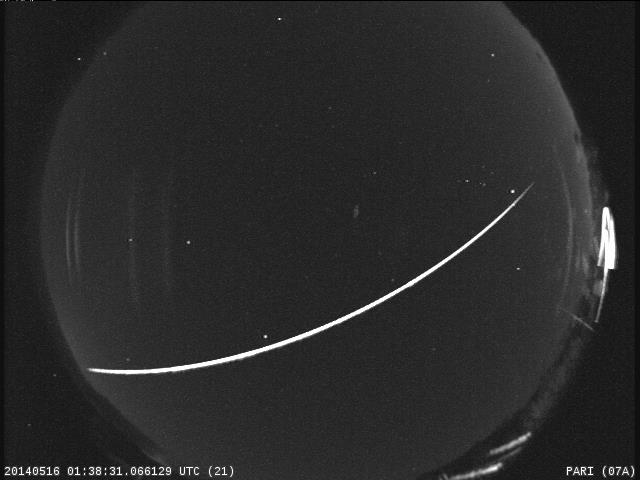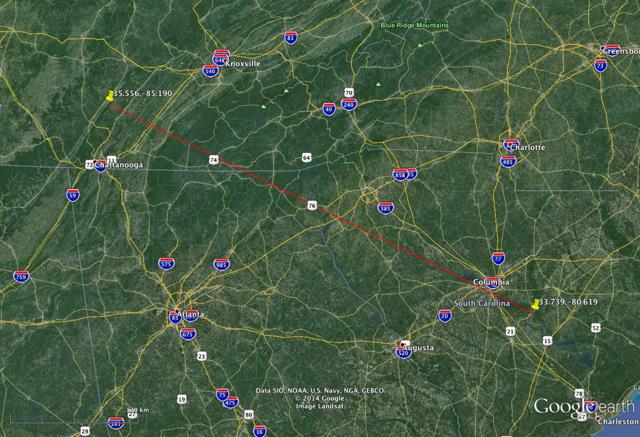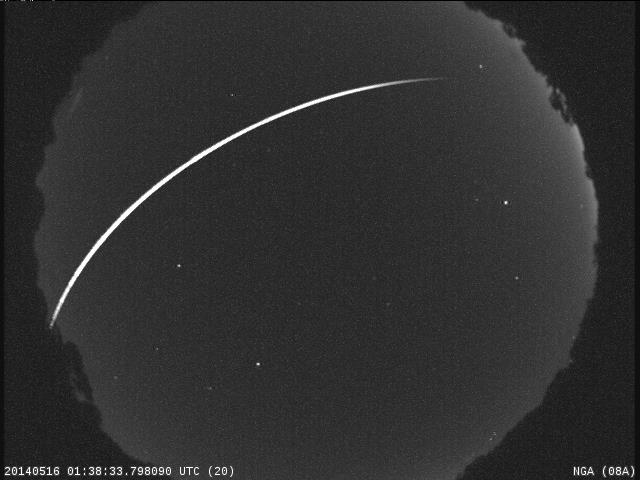Brilliant Fireball Streaks Over Southeastern US (Video, Photos)

A rare, long-lasting fireball streaked through the skies of the southeastern United States Thursday night (May 15), putting on a show for stargazers lucky enough to see it from the ground.
The space rock entered Earth's atmosphere above Columbia, South Carolina. The basketball-sized meteoroid then moved northwest at about 78,000 mph (125,500 km/h), burning up above Tennessee, according to a statement from Bill Cooke of NASA's meteoroid environment office at Marshall Space Flight Center in Alabama. NASA's skyward-pointing cameras captured an amazing video of the long-duration fireball.
"This fireball was not part of any meteor shower and belongs to a class of meteors called Earthgrazers," Cooke wrote in the statement. "These meteors skim along the upper part of the atmosphere before burning up. This one travelled a distance of 290 miles [467 km], which is quite rare for a meteor."
While this fireball is not part of any meteor shower, it does come one week before a new meteor shower is expected to grace the skies. The never-before-seen Camelopardalid meteor shower should peak overnight on May 23 and 24 as Earth passes through a stream of debris left behind by Comet 209P/LINEAR.
The new meteor shower could be as amazing as the annual Perseid meteor shower, which occurs each August. Still, no one knows what to expect; the meteor shower could be incredible, generating a "meteor storm" of 1,000 shooting stars per hour, or it could fizzle out, experts say.
Meteor showers happen when Earth passes through streams of dust and gast sloughed off by cosmic bodies. The debris enters the atmosphere, burning up and creating the light flashes that are sometimes called shooting stars.
A bit of space debris still in space is known as a meteoroid. If that piece of a comet or asteroid enters Earth's atmosphere, it's called a meteor, and any bit of rock that makes it to the planet's surface is dubbed a meteorite.
Breaking space news, the latest updates on rocket launches, skywatching events and more!
Editor's Note: If you capture an amazing photo of the Tennessee fireball, the new meteor shower or any other night sky view that you'd like to share for a possible story or image gallery, please contact managing editor Tariq Malik at spacephotos@space.com.
Follow Miriam Kramer @mirikramer and Google+. Follow us @Spacedotcom, Facebook and Google+. Original article on Space.com.

Miriam Kramer joined Space.com as a Staff Writer in December 2012. Since then, she has floated in weightlessness on a zero-gravity flight, felt the pull of 4-Gs in a trainer aircraft and watched rockets soar into space from Florida and Virginia. She also served as Space.com's lead space entertainment reporter, and enjoys all aspects of space news, astronomy and commercial spaceflight. Miriam has also presented space stories during live interviews with Fox News and other TV and radio outlets. She originally hails from Knoxville, Tennessee where she and her family would take trips to dark spots on the outskirts of town to watch meteor showers every year. She loves to travel and one day hopes to see the northern lights in person. Miriam is currently a space reporter with Axios, writing the Axios Space newsletter. You can follow Miriam on Twitter.


